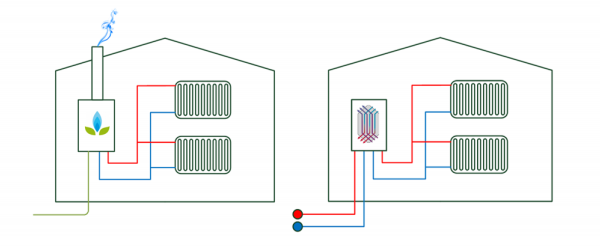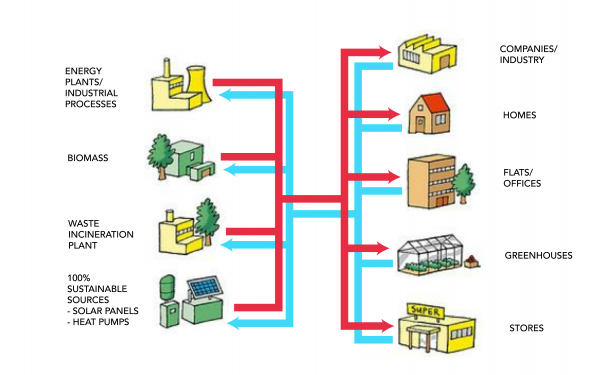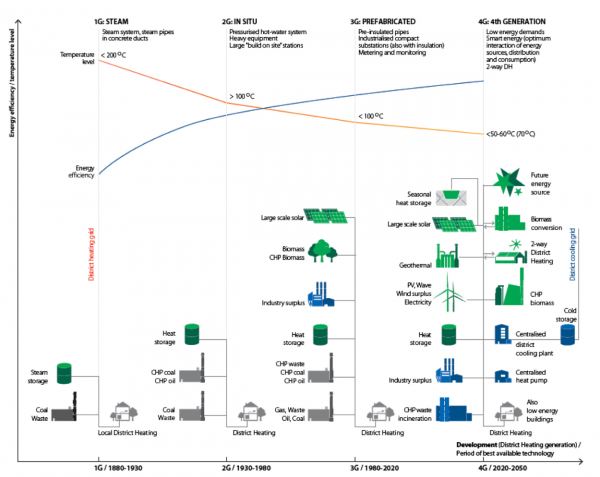After the oil crisis in the 1970s, Belgium ( and later also Flanders) decided to switch massively to natural gas for heating houses and other buildings. In the 1990s, this even led to the government being legally obliged to provide a gas connection in every new-build neighbourhood. The result: today no less than 90% of Flanders is connected to the gas grid.
Water as an energy carrier
Due to the climate issue and other factors such as volatile prices and supply (in)security, heating with gas (and cooling with electricity) is no longer a valid option. A heating network, in which houses and buildings are supplied with water that is already warm – thus, the water is the energy carrier - has many advantages over gas:
The energy is not generated in the houses and buildings themselves by burning gas but delivered to the home as usable heat by generating or collecting the energy in a central system, resulting in a considerable reduction in CO2.
The hot water thus feeds the heat network, which can stretch for many kilometres in an area of preferably dense urban development.
‘More than 50% of our energy consumption is taken up by heating and cooling buildings,' says Ann Wouters of VITO/EnergyVille. If you use heating networks for this, you have a very powerful instrument at your disposal in the transition to a sustainable energy system. Ideally, heating networks are fed by residual heat from companies or by sustainable alternatives such as geothermal energy or biomass. Another significant advantage of a heating network is that the energy source (which is used to heat water centrally) can easily be replaced. In this way, heating networks are compatible with changes in our energy system, which cannot always be predicted.
Other countries are already much more familiar with energy technology. After the 1973 oil crisis, for example, Sweden quickly made the choice to heat with heating networks. There was a similar evolution in the other Scandinavian countries, and even in our neighbouring countries. ‘We are looking very carefully abroad', says Rutger Baeten, 'Scandinavia, in particular, has been working on high-efficiency heating networks in recent years. We are now bringing that knowledge here so that the heating networks we build will immediately be among the best in the class. The advantage, of course, is that in Flanders we have a virtually blank page. We don't have to go through all the teething troubles again.
What is a heating network?
A heating network is essentially a district heating system. So instead of burning fuel (gas, oil) on-site at your home, you get water in a pipe inside your house that is warm enough to heat your home and your domestic hot water.
Does the water from the public mains also flow through the pipes in your radiators or underfloor heating? No, the street water network (or primary network) is separated from the indoor water networks (secondary networks) by a heat exchanger. The heat exchanger (there can also be two: one for the heating circuit and one for the domestic hot water circuit) is built into a device called the heat delivery station or substation.
A heating network has two pipes: a hot pipe (the supply) and a colder pipe (the return). For example, a heating network is often characterised by its supply and return temperatures: it is then called a '90-70 heating network' (supply temperature 90°C, return temperature 70°C), or a '70-55 heating network', where the supply water is 70°C hot and the return water 55°C.
Similar to our water and electricity supplies, a heating network is a network of underground pipes that transports heat from one place to another, i.e. it is a distributor of heat. The heat is brought from, for example, one company to another company, homes, offices or a swimming pool.
Such a heating network can make good use of residual heat from a nearby industrial estate, for example, from (bio)gas boilers, or large central CHPs. A heating network designed for lower supply/return temperatures can make greater use of waste heat, as lower temperature waste heat can also be used to feed the heating network.
Why district heating networks?
Why should we build heating networks in the first place?
Well, heating networks have a favourable ecological impact:
- Using residual heat or sustainable heat sources efficiently
- The air quality in the urban environment improves: as there are far fewer combustion installations in the city centre, NOx, SOx and PM are reduced.
- The future switch to renewable sources will be easier: the heat distribution infrastructure will already be in place, it is only a new central source that needs to be fitted in.
Heating networks also have a favourable economic impact:
- The focus of investment is on infrastructure, rather than fuel
- Deployment of local residual heat and local renewable heat: the money remains in the local economy, and it is a source of income for local businesses and helps to anchor them
- EPB: reduction of the E-level points at a lower cost
Last but not least, heating networks have a favourable geopolitical and social impact:
- Reduction of energy dependency:
- Protection against geopolitical crises
- Protection against major price fluctuations
- Local sustainable employment
An increased level of safety is also included, as there are no longer any combustion plants in individual houses, and there is no longer any gas network in the street.
Does this mean that there are only advantages to heating networks?
No, not exactly. There are also disadvantages:
- A heating network is expensive to build: you need two pipes, each with a diameter many times greater than that of a gas pipe. You also need more space in the subsoil, which in turn entails higher excavation and landfill costs.
- Because it is a collective heating system, the failure of a (primary) system component has an impact on the whole system and on all heat consumers.
However, a well-designed heating network with suitable heat sources and heat demanders has enormous potential and cost-effectiveness where the disadvantages do not outweigh the advantages.
So, we build district heating networks everywhere?
No. It depends on the density of heat consumption whether a heating network is affordable in a given environment and the cost-benefit ratio is sufficiently favourable: are the heat consumers "close enough" to each other. In an urban environment, this is certainly true, but in rural areas, the costs often exceed the benefits. Here, for example, an individual heat pump can be used.
How can I then know whether a heating network is more advantageous, or rather an individual heat pump?
To this end, the Belgian government makes various plans and maps available:
- https://www.energiesparen.be/warmteplan
- https://www.energiesparen.be/warmtekaart en www.geopunt.be
- https://energie.wallonie.be/fr/une-strategie-pour-une-consommation-de-chaleur-plus-durable-en-wallonie.html?IDC=6238&IDD=152026
Also take a look at the Inspiration Map Heat recently presented by the Association of Flemish Cities and Municipalities: https://www.inspiratiekaartwarmtezonering.be/
Note! It is also the case that heating networks and heat pumps can work together in a collective heating system: there are hybrid low-temperature heat networks (e.g. 32-16) in which an individual small booster heat pump ensures the right temperature of the domestic hot water in each house.
Installation
The installation of a heating network system requires different skills and specialisation from the installation technicians: for production, you need the knowledge and skills to install, set up and maintain thermal production systems such as large heat pumps or large CHPs. For the piping network, you need infrastructure installation companies to lay the pipes and connect them together. For the heat capture side, you will need to know how to connect the heat capture station to the primary and secondary grid, and how to set it up correctly. An installation engineer will also need to know more and more about ICT - information and communication technology - as more and more so-called smart heat delivery stations are being developed: they are connected to a central server/database where they send their data, and from where they can receive control signals. On that central server, smart algorithms, such as EnergyVille's STORM District Energy Controller, ensure that the heat network will operate optimally (and therefore as cheaply) at all times and with the available data.
Heating network generations
Why should you, as a plant engineer, get involved in such a novel way of heating?
Well, heating networks are quite old, more than a hundred years, and, like people, they go through different generations. The first generation is roughly between 1880 and 1930, the second generation between 1930 and 1980 and the third generation between 1980 and 2020. The new generation, the fourth - 4G - started in 2020 and is expected to run until 2050. So 4G has barely begun and is certainly not yet the standard: 90% of all new grids built in the EU are still 3G.
The transition between these generations is characterised by disruptive technological innovations. In 1G -> 2G this was the transition from steam to water as an energy carrier, in 2G -> 3G: pre-insulated pipes, and, now we come to "digital heating networks", in 3G -> 4G: the addition of information and communication technology - ICT - to the infrastructure, "smart energy".
Nowadays, there is also talk of a fifth-generation heating network, in which the heat removed from one building, which is therefore cooled, serves as heating for another building.
Heating networks in Belgium
In Belgium, we have had heating networks for quite some time now: Roeselare, Bruges, Ghent, Mol,... have been active for decades.
For an overview of the heating networks:
- in Flanders, https://dashboard.vreg.be/report/Warmtenetkaart.html
- in the Walloon region, https://energie.wallonie.be/fr/une-strategie-pour-une-consommation-de-chaleur-plus-durable-en-wallonie.html?IDC=6238&IDD=152026
Several cities have also expressed their ambition to make full use of heating networks; for example, the Roadmap Heating Network 2030 in Antwerp is in the approval phase, where the core infrastructure of a city-wide heating network is proposed.
Much more to be said about heating networks
Anyone interested in learning more about heating networks is welcome to attend the 3rd District Heating Workshop Antwerp on 2 June 2022 at the Provinciehuis in Antwerp: https://www.districtheatingantwerpen.be/nl/ . The seminar is free, but you need to register in advance. Or you can contact Erik De Schutter for more information.
What about cooling networks?
In addition to the emphasis on heating, cooling is also increasingly discussed. After all, a heating network is only active for part of the year, during the cold season, and is dimensioned accordingly. It would be nice if the network could not only be depreciated for use during the cold period but could also be used during the warmer period of the year. This is called a heat-cold network, where the water in the low-temperature pipe can be used to cool the home.
This article is a translation of the article written by Erik De Schutter, Dirk Vanhoudt and Rutger Baeten for Techlink's HEAT+ Magazine



